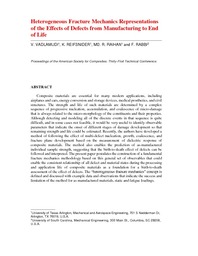| dc.contributor.author | Vadlamudi, Vamsee | |
| dc.contributor.author | Reifsnider, Kenneth | |
| dc.contributor.author | Raihan, Rassel | |
| dc.contributor.author | Rabbi, Fazle | |
| dc.date.accessioned | 2018-03-21T01:15:55Z | |
| dc.date.available | 2018-03-21T01:15:55Z | |
| dc.date.issued | 2016-09 | |
| dc.identifier.citation | Published in the Proceedings of the American Society for Composites, 2016 | en_US |
| dc.identifier.uri | http://hdl.handle.net/10106/27291 | |
| dc.description | American Society for Composites: Thirty-First Technical Conference, September 19-22, 2016, Williamsburg, Virginia | en_US |
| dc.description | Composite materials are essential for many modern applications, including airplanes and cars, energy conversion and storage devices, medical prosthetics, and civil structures. The strength and life of such materials are determined by a complex sequence of progressive nucleation, accumulation, and coalescence of micro-damage that is always related to the micro-morphology of the constituents and their properties. Although detecting and modeling all of the discrete events in that sequence is quite difficult, and in some cases not feasible, it would be very useful to identify observable parameters that indicate the onset of different stages of damage development so that remaining strength and life could be estimated. Recently, the authors have developed a method of following the effect of multi-defect nucleation, growth, coalescence, and fracture plane development based on the measurement of dielectric response of composite materials. The method also enables the prediction of as-manufactured individual sample strength, suggesting that the birth-to-death effect of defects can be followed and interpreted. The present paper postulates the construction of a fundamental fracture mechanics methodology based on this general set of observables that could enable the consistent relationship of all defect and material states during the processing and application life of composite materials as a foundation for a birth-to-death assessment of the effect of defects. The “heterogeneous fracture mechanics” concept is defined and discussed with example data and observations that indicate the success and limitation of the method for as manufactured materials, static and fatigue loadings. | en_US |
| dc.description.abstract | Composite materials are essential for many modern applications, including
airplanes and cars, energy conversion and storage devices, medical prosthetics, and civil
structures. The strength and life of such materials are determined by a complex
sequence of progressive nucleation, accumulation, and coalescence of micro-damage
that is always related to the micro-morphology of the constituents and their properties.
Although detecting and modeling all of the discrete events in that sequence is quite
difficult, and in some cases not feasible, it would be very useful to identify observable
parameters that indicate the onset of different stages of damage development so that
remaining strength and life could be estimated. Recently, the authors have developed a
method of following the effect of multi-defect nucleation, growth, coalescence, and
fracture plane development based on the measurement of dielectric response of
composite materials. The method also enables the prediction of as-manufactured
individual sample strength, suggesting that the birth-to-death effect of defects can be
followed and interpreted. The present paper postulatesthe construction of a fundamental
fracture mechanics methodology based on this general set of observables that could
enable the consistent relationship of all defect and material states during the processing
and application life of composite materials as a foundation for a birth-to-death
assessment of the effect of defects. The “heterogeneous fracture mechanics” concept is
defined and discussed with example data and observations that indicate the success and
limitation of the method for as manufactured materials, static and fatigue loadings. | |
| dc.language.iso | en_US | en_US |
| dc.publisher | American Society for Composites | en_US |
| dc.publisher | DEStech Publications, Inc. | en_US |
| dc.subject | Composite materials -- defects | en_US |
| dc.subject | Heterogeneous material -- dielectric response | en_US |
| dc.subject | Fracture mechanics -- methodology | en_US |
| dc.title | Heterogeneous Fracture Mechanics Representations of the Effects of Defects from Manufacturing to End of Life | en_US |
| dc.type | Conference Proceeding | en_US |
| dc.publisher.department | University of Texas at Arlington Research Institute (UTARI), University of Texas at Arlington | en_US |
| dc.identifier.externalLink | http://dpi-proceedings.com/index.php/asc31/article/view/3333 | |
| dc.identifier.externalLinkDescription | The original publication is available at the journal homepage | en_US |


